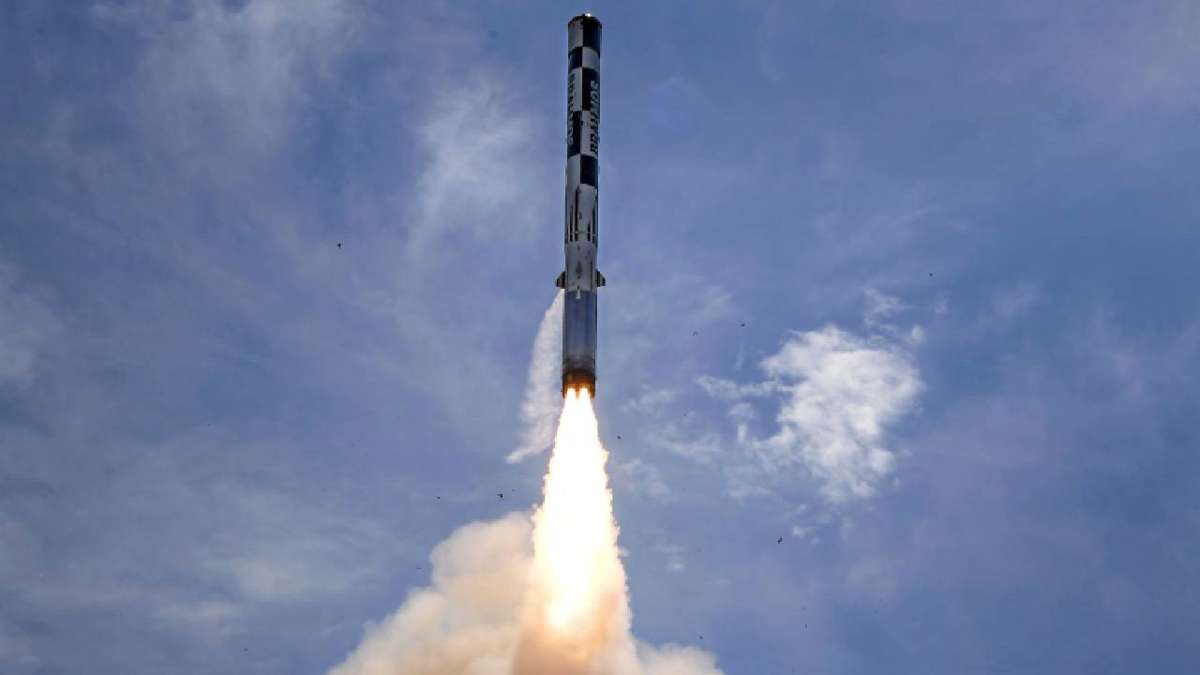Monthly Archives: May 2025
SOURCE: RAUNAK KUNDE / NEWS BEAT / IDRW.ORG


In a significant development amid escalating tensions between India and Pakistan, debris believed to be from a 40N6E long-range surface-to-air missile (SAM), part of the Indian Air Force’s (IAF) S-400 Sudarshan Chakra air defense system, has been recovered in Gujrat, Pakistan. Reports from sources close to the Indian Defence Research Wing (idrw.org) suggest that the missile, fired during a recent aerial engagement on the night of May 7-8, 2025, struck a moving target in Pakistani airspace.
However, the nature of the target remains unclear, and the absence of visible electronics in the missile fragments indicates it was fully expended, confirming a successful hit. This incident, tied to India’s response to Pakistan’s attempted drone and missile attacks, underscores the S-400’s formidable capabilities and raises questions about the dynamics of the ongoing conflict.
Continue readingSOURCE: RAUNAK KUNDE / NEWS BEAT / IDRW.ORG


In a significant operational milestone, the Indian Air Force (IAF) deployed the Netra Mk1A testbed, originally developed by the Defence Research and Development Organisation (DRDO) for testing purposes, during Operation Sindoor on May 7, 2025. According to a report by aerospace journalist Anantha Krishnan M, sources within the IAF confirmed that the Netra Mk1A Airborne Early Warning and Control (AEW&C) system performed flawlessly, playing a pivotal role in the operation.
The Netra Mk1A, an advanced iteration of the DRDO’s Netra AEW&C program, is a force multiplier designed to enhance situational awareness and command-and-control capabilities. Mounted on an Embraer ERJ-145 platform, the Netra Mk1A features an indigenously developed Active Electronically Scanned Array (AESA) radar, capable of detecting and tracking airborne and ground targets at ranges up to 240 kilometers. With 240-degree radar coverage, advanced electronic countermeasures, and secure communication systems, the system provides real-time intelligence, surveillance, and reconnaissance (ISR) to IAF commanders. The testbed, initially used to validate upgrades for the Netra Mk1A program, was pressed into operational service during Operation Sindoor, demonstrating its readiness and reliability under combat conditions.
Continue readingSOURCE: RAUNAK KUNDE / NEWS BEAT / IDRW.ORG


In a significant leap forward for India’s defense capabilities, sources close to the Indian Defence Research Wing (idrw.org) have revealed that the BrahMos supersonic cruise missile was recently tested for an extended range of 800 kilometers, marking a historic milestone in its development.
This test, conducted in the Bay of Bengal, is believed to be the first successful demonstration of the BrahMos missile’s 800km variant, significantly enhancing India’s offensive firepower and strategic deterrence.
Continue readingSOURCE: AFI


In a significant escalation of tensions between India and Pakistan, reports have emerged of an Indian missile strike targeting the Pakistan Air Force’s (PAF) No. 6 Squadron, nicknamed the “Antelopes,” at Nur Khan Air Base. The No. 6 Squadron, the PAF’s oldest transport squadron, operates a fleet of C-130 Hercules and CN-235 transport aircraft, playing a critical role in logistical and transport operations for the Pakistani military.
According to initial reports and visuals circulating on social media, one aircraft at the base appears to be engulfed in flames, with the fire centered near a C-130 aircraft parked on the tarmac. The extent of the damage to the aircraft, infrastructure, and personnel remains unclear, as official statements from both the Pakistani and Indian governments are yet to be released. The visuals suggest a precise strike, potentially aimed at disrupting the PAF’s transport capabilities.
Continue readingSOURCE: AFI


In a significant display of its air defence capabilities, India successfully intercepted and destroyed a Pakistani Fatah-1 surface-to-surface missile over Sirsa, Haryana, around 12:15 AM on May 10, 2025. The missile, launched by Pakistan as part of its “Operation Bunyan ul Marsoos,” was targeting an undisclosed strategic location in India but was neutralized by the Indian Air Force’s Barak-8 air defence system, according to government sources. This incident marks a critical escalation in the ongoing tensions between the two nuclear-armed neighbors, following a series of cross-border drone and missile attacks.
The Fatah-1, an indigenously developed Pakistani missile with a reported range of 140 kilometers, is designed for precision strikes against tactical targets such as military bases and command centers. Pakistani military officials have claimed its advanced navigation system enhances accuracy, posing a challenge to regional air defence systems. However, India’s Barak-8, a medium-range surface-to-air missile system developed jointly by India’s DRDO and Israel’s IAI, proved its efficacy by detecting and intercepting the incoming projectile. The Barak-8, with a range of 70 to 150 kilometers, is a key component of India’s multi-layered air defence grid, complementing systems like the Russian S-400 Triumf and the indigenous Akash.
Continue readingSOURCE: AFI


In a significant escalation of tensions between India and Pakistan, the Indian Ministry of Defence confirmed that Pakistan launched an unprecedented 300-400 Turkish-made SONGAR drones in a coordinated attempt to infiltrate Indian airspace across 36 locations, stretching from Leh in Ladakh to Sir Creek in Gujarat, on the night of May 8-9, 2025. The Indian Armed Forces, leveraging advanced air defense systems, including the S-400 and SAMAR platforms, successfully neutralized the majority of these threats, marking a decisive response to Pakistan’s aggressive maneuver.
According to official statements and posts on X, Pakistan deployed approximately 300-400 SONGAR drones, manufactured by Turkey’s AS?SGUARD, in a large-scale operation targeting Indian military installations along the Line of Control (LoC) and International Border. The drones, identified as Turkish-origin by Indian defense officials, were launched across a 1,800-km stretch of Indian territory, from the high-altitude regions of Leh to the coastal marshes of Sir Creek.
Continue readingSOURCE: AFI


The Indian Air Force (IAF) has officially confirmed the successful deployment of its indigenously developed SAMAR (Surface-to-Air Missile for Assured Retaliation) system, marking a significant milestone in India’s air defense capabilities. The SAMAR system has proven its mettle in combat, effectively neutralizing drone incursions by Pakistan, establishing itself as a battle-proven platform.
The SAMAR system, developed by the IAF in collaboration with Indian defense industries, is designed to counter low-flying threats, including unmanned aerial vehicles (UAVs) and drones. Equipped with advanced radar and missile technology, SAMAR provides rapid response and precision targeting, ensuring assured retaliation against hostile aerial intrusions. Its compact and mobile design allows for swift deployment across diverse terrains, making it a versatile asset for India’s defense forces.
Continue readingSOURCE: UNI


Pakistan has alleged that Indian missiles and drones struck three of its airbases early Saturday — Nur Khan, Murid, and Rafiqui. According to the Pakistan military spokesperson said that the country’s air defence system successfully intercepted several incoming missiles. The press briefing was cut short without further explanation.
India overnight successfully struck four key Pakistani airbases, inflicting heavy damage on military installations and assets, government sources said on Saturday. The targeted airbases include Noor Khan in Rawalpindi, Murid in Chakwal, and Rafiqui in Shorkot.
Continue readingSOURCE: PTI
)

India on Friday night repelled fresh drone attacks from Pakistan at 26 locations in the country’s north and west including Srinagar airport, as it accused Islamabad of using its civilian planes as a shield for its aerial strikes endangering their flights.
As Pakistan targeted several cities for the third consecutive night, this time from Baramulla in north Kashmir to Bhuj in Gujarat, the government said Islamabad had launched between 300 and 400 Turkish drones across 36 locations from Leh to Sir Creek in its failed attempt to target Indian military installations on Thursday night.
Continue readingSOURCE: IANS


Rattled by Indian military strikes on terror bases inside its territory, the Pakistan government and its army have gone into overdrive to save face, first, by launching drones and UAVs on Indian territory and then, activating its propaganda machinery to spread fake and fabricated impression that it got an edge over Indian forces in the military face-off.
In a bid to project it as the superior force, Pakistan is only exposing its duplicity. The contrasting claims by the Pakistan Army and its Defence Minister Khwaja Muhammed Asif regarding Indian drone strikes has caught the attention of netizens, and this has only made them a laughing stock.
Continue readingSOURCE: PTI


US President Donald Trump wants to see the conflict between India and Pakistan de-escalate “as quickly as possible,” the White House said on Friday.
The comments by White House Press Secretary Karoline Leavitt came as military action between India and Pakistan intensified following India’s strike on nine terror sites in Pakistan and Pakistan-occupied Kashmir(PoK) under ‘Operation Sindoor’ early Wednesday. India’s strike was a powerful retaliation to the Pahalgam massacre on April 22, in which 26 people, mostly tourists, were killed.
Continue readingSOURCE: ANI


Amid rising tensions between India and Pakistan, Jonathan Spyer, Director of Research at the Middle East Forum, emphasised that much of the media coverage is missing the real reason behind the current India-Pakistan tension. He said the root cause is Pakistan’s long-standing practice of using Islamist militant groups as tools of state policy. Spyer further said that India’s strong response is a reaction to this pattern, and while efforts to reduce tensions are important, one should not forget what triggered the conflict in the first place.
In an interview with ANI, Spyer said, “It is clear that there has been a very serious escalation over the last few days, and it is notable that the US administration, now, including Secretary of State Marco Rubio, are becoming involved in efforts to de-escalate. I think alarmism would be mistaken, the kind of reports which are saying, well, two nuclear armed powers are now on the edge of warfare, this is exaggerated.
Continue readingSOURCE: ANI


Escalating the tensions even further, one Paksitani drone hit a residential area in Firozpur, Punjab on Friday, injuring three people. Three people suffered burn injuries and were immediately rushed to the hospital, SSP Ferozepur, Bhupinder Singh Sidhu said. “We received information about 3 people being injured. They have burn injuries. Doctors will treat them. Most of the drones have been neutralised by the army,” Bhupinder Singh Sidhu said.
Indian Air Defnce have intercepted most of the drones in the Firozpur area. Further details are awaited. A day after Pakistan’s attempt to target civilian infrastructure along the Line of Control and International border was foiled by the Indian air defence, the neighbour country’s drones were again sighted in Jammu, Samba, Pathankot sector on Friday.
Continue readingSOURCE: PTI
)

The International Monetary Fund (IMF) on Friday approved the immediate disbursement of about $1 billion to Pakistan under the ongoing Extended Fund Facility. In a statement, the Washington-based global lender said its Executive Board concluded the initial review of Pakistan’s economic reform programme under the Extended Fund Facility (EFF) arrangement.
“This decision allows for an immediate disbursement of around $1 billion (SDR 760 million), bringing total disbursements under the arrangement to about $2.1 billion (SDR 1.52 billion),” the agency said.
Continue readingSOURCE: IANS


A soldier from Andhra Pradesh has been killed in the heavy shelling by the Pakistan Army along the Line of Control (LoC) in Jammu and Kashmir. Murali Nayak of the Sri Sathya Sai district lost his life in the indiscriminate shelling by the Pakistan Army.
The jawan, hailing from Kallithanda village under Gaddamthanda panchayat, was on duty on the front lines. His mortal remains are expected to reach his native place on Saturday. It was immediately not clear if Nayak was killed in the shelling on Wednesday or Thursday.
Continue reading